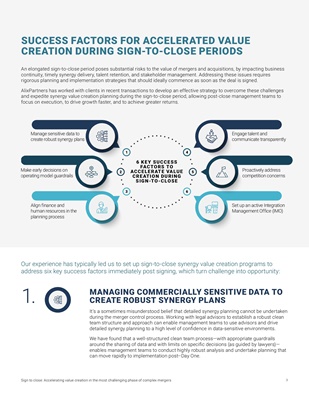
Sign-to-close: Accelerating value creation in the most challenging phase of complex mergers 3
SUCCESS FACTORS FOR ACCELERATED VALUE
CREATION DURING SIGN-TO-CLOSE PERIODS
An elongated sign-to-close period poses substantial risks to the value of mergers and acquisitions, by impacting business
continuity, timely synergy delivery, talent retention, and stakeholder management. Addressing these issues requires
rigorous planning and implementation strategies that should ideally commence as soon as the deal is signed.
AlixPartners has worked with clients in recent transactions to develop an effective strategy to overcome these challenges
and expedite synergy value creation planning during the sign-to-close period, allowing post-close management teams to
focus on execution, to drive growth faster, and to achieve greater returns.
6 KEY SUCCESS
FACTORS TO
ACCELERATE VALUE
CREATION DURING
SIGN-TO-CLOSE
Manage sensitive data to
create robust synergy plans
Make early decisions on
operating model guardrails
Align finance and
human resources in the
planning process
Engage talent and
communicate transparently
Proactively address
competition concerns
Set up an active Integration
Management Office (IMO)
Our experience has typically led us to set up sign-to-close synergy value creation programs to
address six key success factors immediately post signing, which turn challenge into opportunity:
MANAGING COMMERCIALLY SENSITIVE DATA TO
CREATE ROBUST SYNERGY PLANS
It's a sometimes misunderstood belief that detailed synergy planning cannot be undertaken
during the merger control process. Working with legal advisors to establish a robust clean
team structure and approach can enable management teams to use advisors and drive
detailed synergy planning to a high level of confidence in data-sensitive environments.
We have found that a well-structured clean team process-with appropriate guardrails
around the sharing of data and with limits on specific decisions (as guided by lawyers)-
enables management teams to conduct highly robust analysis and undertake planning that
can move rapidly to implementation post-Day One.
1.